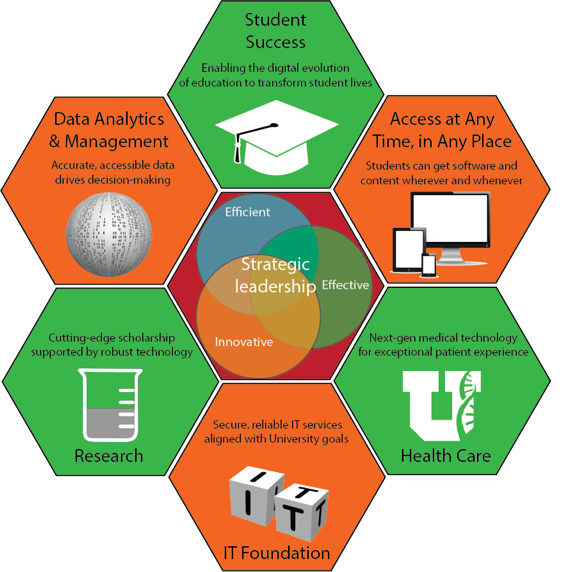You’re accessing archived content
This is archived content from the UIT website. Information may be outdated, and links may no longer function. Please contact stratcomm@it.utah.edu if you have any questions about archived content.
Hess: The university's future goes through IT
 |
|
Steve Hess, CIO |
The University of Utah’s Four Big Goals represent the rich diversity of our institution’s mission, calling on our talents in teaching, healthcare, and research and a desire to ensure its ability to deliver on those areas for generations to come.
Just underneath the surface of those four goals lie two bedrock needs that support them all: information, and reliable and secure access to that information. As information technology practitioners, we are critical to the university’s ability to meet those goals. The systems and services we provide are essential components to the current and future success of higher education, so much so that I believe those IT services and the university goals are woven together with the same thread.

This IT honeycomb represents that interconnectivity. Three of the Four Big Goals sit alongside the IT requirements that fuel them: a strong IT foundation, data analytics and management, and secure access free of time and place. Binding them all together is strategic leadership, which rewards effective, efficient, and innovative solutions — the kind that promote scalability and sustainability, the fourth Big Goal.
What must we do to meet this challenge?
A strong IT foundation
The services we offer must be reliable, resilient, and appropriate. They must evolve to meet not only the university’s current needs, but its future ones, as well. To that end, our strategic plan seeks to increase baseline funding to ensure the network is capable of performing as demanded. It looks to harden the secondary network node, reduce duplication, improve service management, and adopt technologies that improve the campus experience.
In addition, we want to be proactive in understanding our users’ needs and communicate with them through the various levels of governance. To have a strong foundation, you have to know what will sit on top of it and build accordingly. I believe we have done that in all aspects — networking and infrastructure, unified communications services, security, applications, research computing, and teaching and learning services.
Data analytics and management
It isn’t possible to stress enough the importance of timely, reliable, and actionable data for university decision-makers. Modern-day educators are using real-time information about student behavior and results to course-correct on an individual basis and personalize the student experience.
This is a monumental shift in education, and it is being powered by information technology. We recognize this need will only increase, so we are experimenting with machine learning under the supervision of our business intelligence team. As an IT organization, we help decision-makers collect and analyze meaningful metrics that can be used to make substantive, informed choices in the best interest of the university.
In the health care sector, technology has become even more critical to delivering world-class patient care. Network-enabled devices, electronic medical records, and smart buildings are reshaping the way we practice medicine — all on the back of IT.
Access free of time and place
No longer is a college education limited by geography or business hours. More than 50 percent of University of Utah students have taken an online course. Most students use online resources and software to complete their coursework from anywhere they like. Our research shows they expect to be able to do their work on their schedule while reducing the number of times they must come to campus to access resources.
We will help facilitate this through sound identity management and security practices, appropriate enterprise solutions, forward-thinking licensing and ongoing dialog with the faculty and staff who interact with students on a daily basis.
Strategic leadership
Finally, as we state in our UIT values, we will always seek effective solutions that meet the needs of our clients and can save time and money, and innovate and improve processes. Technology can go a long way to reducing overhead while improving outcomes when it is properly vetted and applied. When we enable our colleagues to do more with less, we free them to shift their focus from areas where IT can do the heavy lifting to areas where it can’t. That allows the university to adapt to new demands without bearing the full brunt of new costs.
All of this is possible when we work together — across academic, research, healthcare, and administrative units — to create the best possible holistic experience for our students, patients, researchers, faculty, and staff. The future of higher education will be markedly different from its past, and I have every reason to believe the University of Utah will continue to evolve to meet the challenge ahead.
Node 4
Our monthly newsletter includes news from UIT and other campus/ University of Utah Health IT organizations, features about UIT employees, IT governance news, and various announcements and updates.
